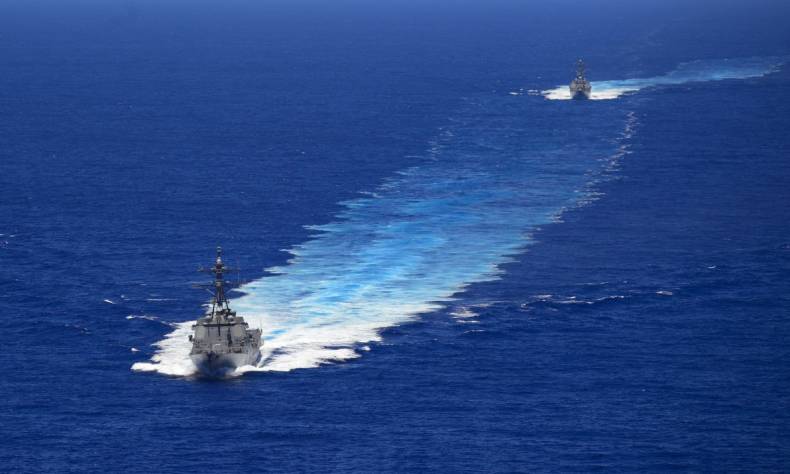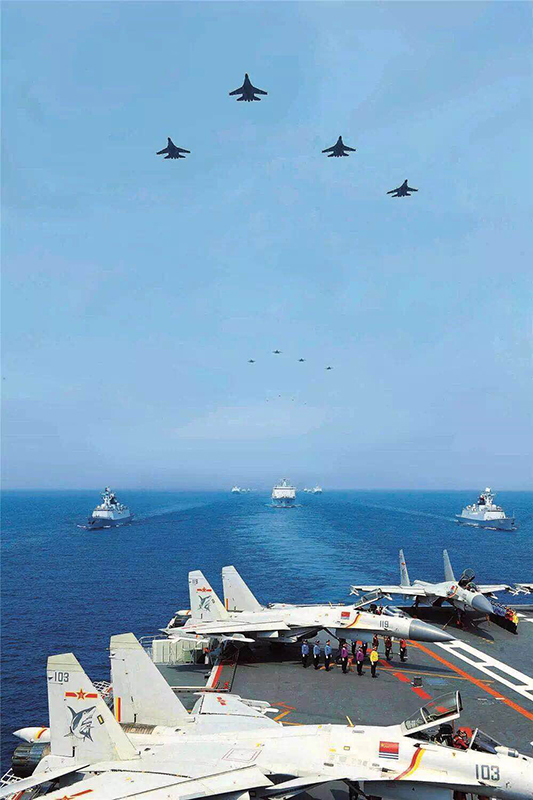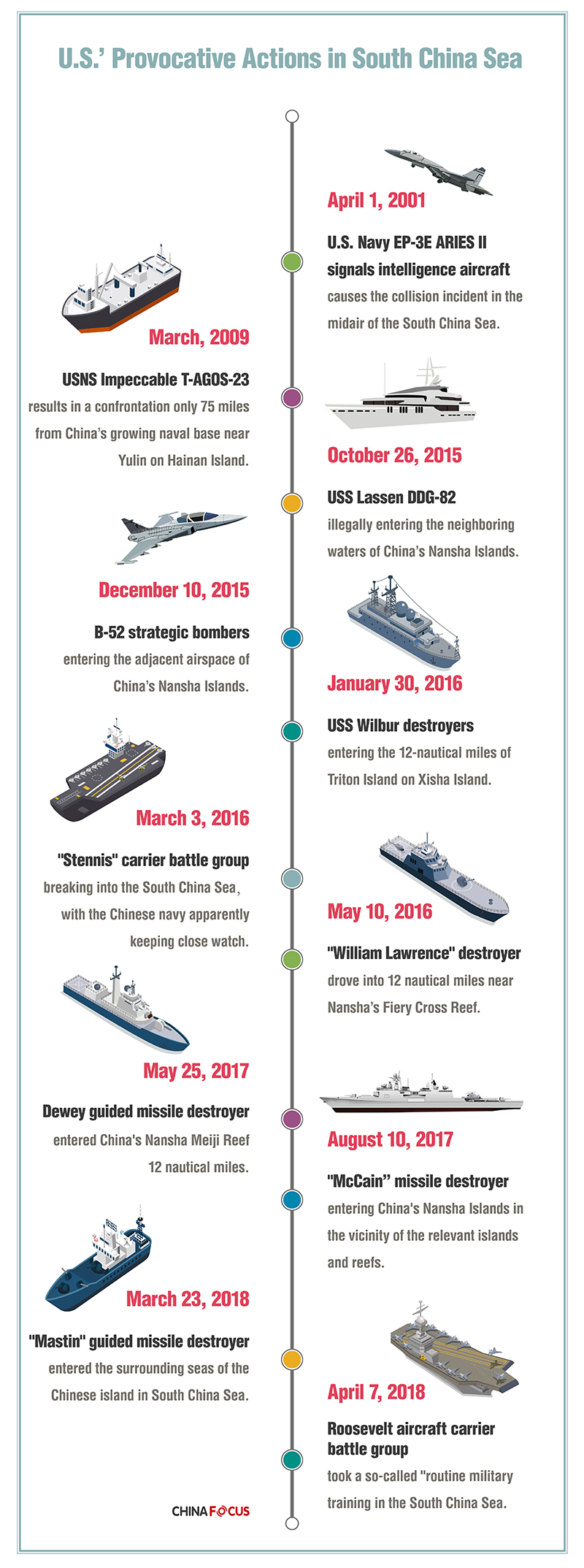
Who is Responsible for South China Sea Militarization?
Recently, a small number of politicians and the media in the U.S. are making up the same trick, claiming alarmingly that China has expanded its military capabilities in the South China Sea and engaged in “militarization.”
By Li Guoqiang
Since the second half of 2016, under the joint efforts of China and the neighboring countries of the South China Sea, the situation in the region has gradually calmed down. However, for fear of making no profits out of a peaceful situation, the United States are making up “topics” one after another to create tensions out of nothing and dispatched warships and naval vessels arbitrarily to disrupt the situation while the countries concerned are making active efforts to achieve peace and stability in the area. Recently, a small number of politicians and the media in the United States are making up the same trick, claiming alarmingly that China has expanded its military capabilities in the South China Sea and engaged in “militarization.”
In order to achieve its own Asia-Pacific strategy, the United States has made every effort to strengthen the building of a military alliance system in the Asia-Pacific region. In addition, it has adopted more aggressive provocations on this issue, ignoring the principles of international relations and international law. Moreover, it thinks nothing of other countries ‘sovereignty and interests. In the South China Sea, it unscrupulously pursues its “Freedom of Navigation Program” and uses military strength to forcefully maintain its military presence. In fact, it is the United States that promotes the “militarization” tendency.
Groundless Accusation Against China is Purely a Cart Before the Horse
The United States claims that China is conducting Reef construction on Nansha Islands under the guise of militarization, which is a very absurd accusation.
As is known to all, since ancient times, China has owned the sovereignty and related rights and interests of the South China Sea islands and its adjacent sea areas. China has always committed itself to defend peace and stability in the region. In order to achieve the beautiful vision of making the area a “sea of peace, sea of cooperation, and sea of friendship,” the Chinese government and people have exerted tremendous efforts to abide by the norms of international relations and the basic principles of international law, including The United Nations Convention on the Law of the Sea (UNCLOS). All the efforts ranging from the proposal of the principle of “shelving disputes and joint development” to the establishment of the China-ASEAN Sea Fund, “dual-track” approach to solve the issue, and the “21st Century Maritime Silk Road” are fully reflecting the Chinese government’s patience and sincerity in settling the dispute practically and rationally.
What is wrong with China implementing construction on its own territory? Why cannot China deploy the necessary national defense facilities on its own territory? Peace building and the deployment of defense facilities are the natural rights enjoyed by a sovereign country. No country has the right or the qualification to judge the actions of other countries. Moreover, China’s island and reef construction in the South China Sea is an international obligation under international law. And China’s deployment of defense facilities in this region is never meant to confront against any countries but for self-protection.
It is puzzling that the United States has never inspected its illegal entry into China’s maritime jurisdiction nor ceased its military operations in the area to defiant China’s sovereignty. There is no explanation but for “hegemony” or “overbearing” for the double standard. Regrettably, some individual countries in this region somehow remained indifferent to external and dangerous military actions exemplified by the United States, but made groundless accusations against China. This is purely putting a cart before the horse.
After the turmoil in the South China Sea arbitration case, there are countries that have really cherished the hard-won positive interaction in the region. Together with China, they are committed to maintaining the tranquility. In May 2017, China and ASEAN countries reached an agreement on a draft frame for the “Declaration on the Conduct of Parties in the South China Sea (DOC)”, and related negotiations are being carried out in a smooth and orderly manner. The region has already shown a good trend toward stabilization. If there is a “militarization” trend in the region, then its roots originate from the US.
U.S. is the Source of the “Militarization” Trend in the South China Sea
The United States is located far from the South China Sea. Although it is not a party to the issue, its military power has long existed. In recent years, the United States has frequently dispatched military forces to invade in the South China Sea area in the name of implementing the so-called “Freedom of Navigation (FON)” Its premeditated provocation has continuously intensified the tense atmosphere of the militarization of the region and poses the most serious and realistic threat to peace and stability in the region.
Just take a look at the United States’ provocative actions in South China Sea: the collision incident in April 2001; the USNS Impeccable confrontation in March 2009; the American USS Lassen DDG-82 illegally entering the neighboring waters of the relevant islands and reefs in the Nansha Islands of China on October 26, 2015; the two U.S. military B-52 strategic bombers entering the adjacent airspace of China’s Nansha Islands without permission on December 10; the USS Wilbur destroyers entering the 12-nautical miles of Triton Island on Xisha Island on January 30; 2016, the “Stennis” carrier battle group breaking into the South China Sea on March 3rd; the United States Navy destroyer “William Lawrence” (Burke) drove into 12 nautical miles near Fiery Cross Reef on May 10, the U.S. Dewey guided missile destroyer entered China’s Nansha Meiji Reef 12 nautical miles on May 25, 2017; the U.S. destroyer “Sternsam” entering the 12-nautical-mile island of China’s Triton Island on Xisha Island on July 2; the U.S. military ” The McCain missile destroyer entering China’s Nansha Islands in the vicinity of the relevant islands and reefs without permission of the Chinese government on August 10.
In 2018, the United States still did not stop military harassment in the region. On March 23, the U.S. “Mastin” guided missile destroyer entered the surrounding seas of the Chinese island in South China Sea without authorization; on April 7, the US Army Roosevelt aircraft carrier battle group took a so-called “routine military training. At the same time, senior military officials deliberately played up the so-called “war threat” and unremittingly released signs of intentional military confrontation in the area.
South China Sea is not a Paradise for External Forces
The South China Sea is not a military exercise ground for. It must not allow external forces to deploy its troops and armies nor allow military vessels and warships of external forces to rampage, let alone allowing external forces to trample on China’s sovereignty with so-called military power. In the face of the growing maritime military threat from outside forces, China, as a responsible country, must enhance its ability to protect its national sovereignty and security and must take the responsibility to shoulder the mission of maintaining peace and stability in the region. No country or anyone can prevent China from maintaining its determination and will to safeguard the country’s territorial integrity and development interests. Anybody or any country should not expect China to abandon its legitimate island and reef construction and necessary defensive disposition. Only by work together in a concerted effort, can neighboring countries and China maintain peace and stability in the South China Sea region.
Li Guoqiang, Researcher of the Chinese Frontier Institute of the Chinese Academy of Social Sciences
Editor: Cai Hairuo, Gao Ming
(The article represents the author’s personal opinion which does not represent the China Focus’ stance.)
 Facebook
Facebook
 Twitter
Twitter
 Linkedin
Linkedin
 Google +
Google +












